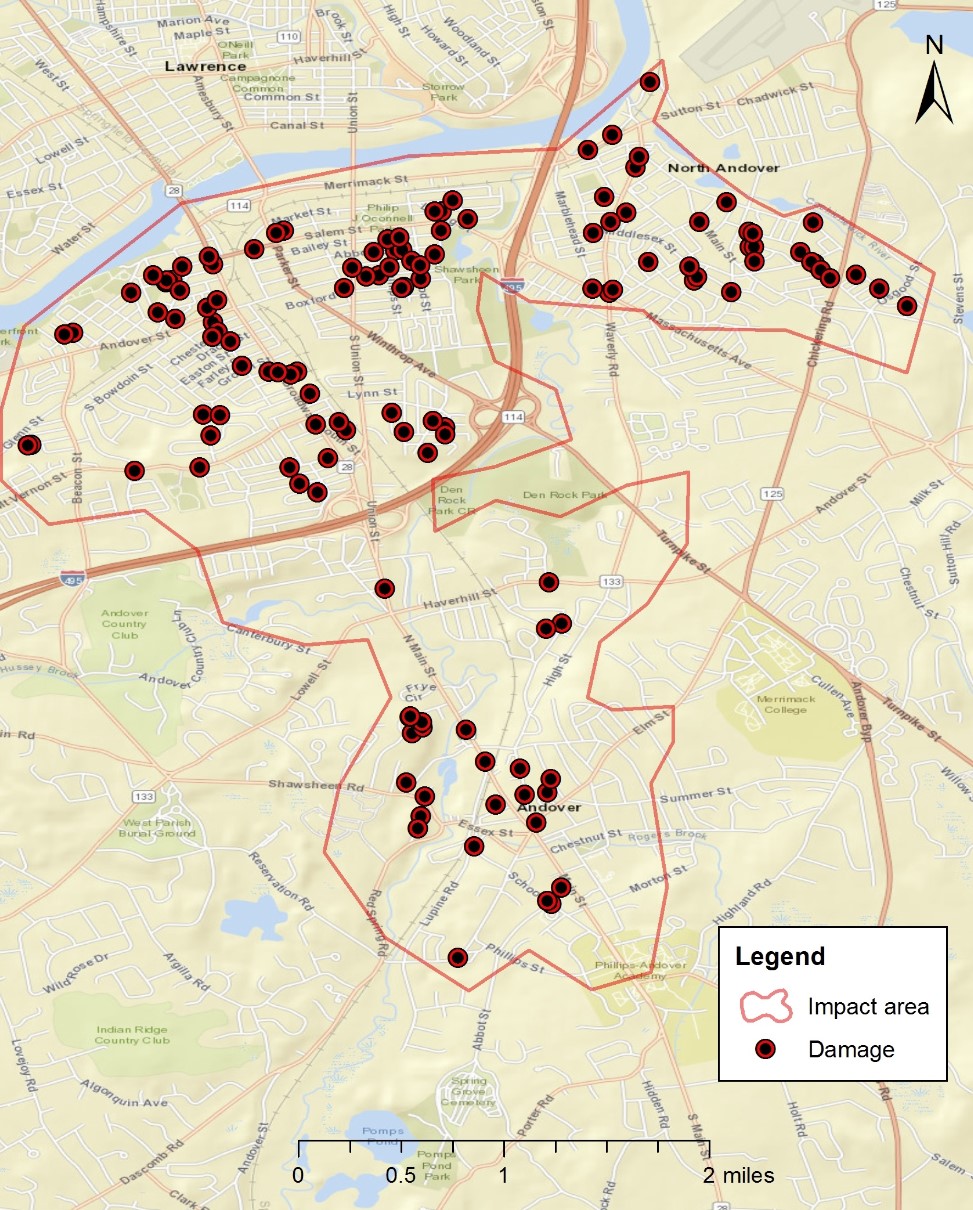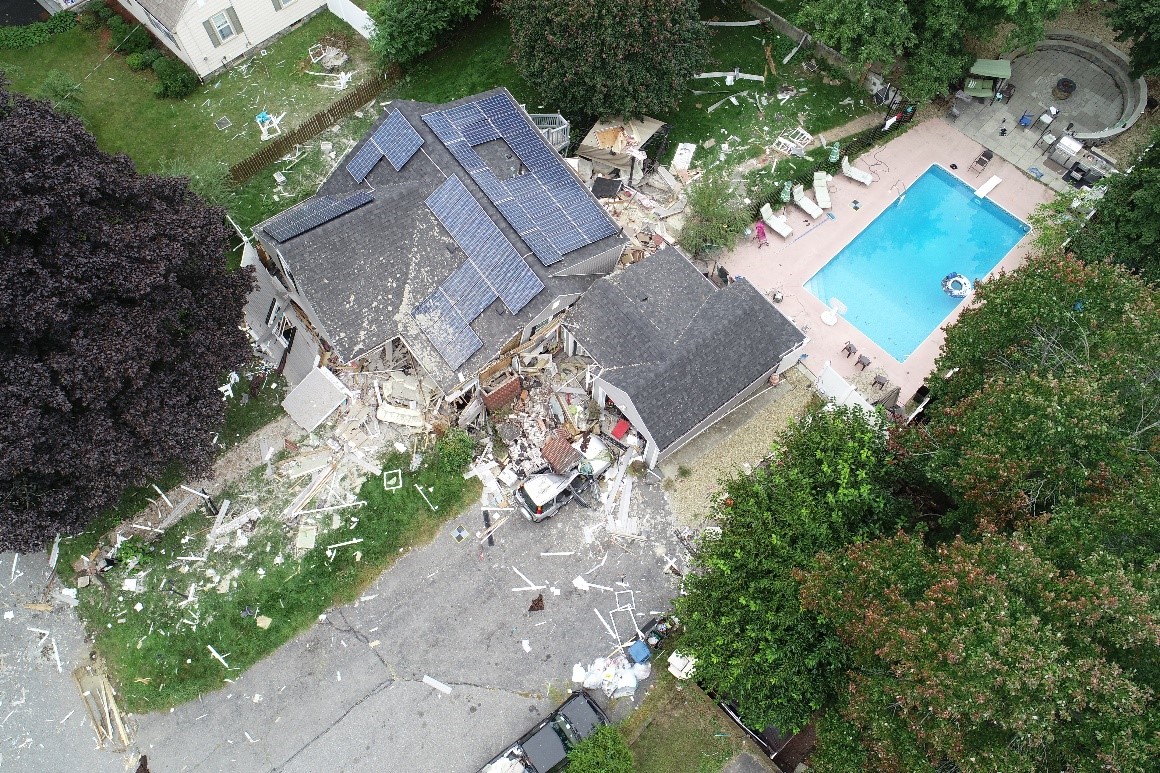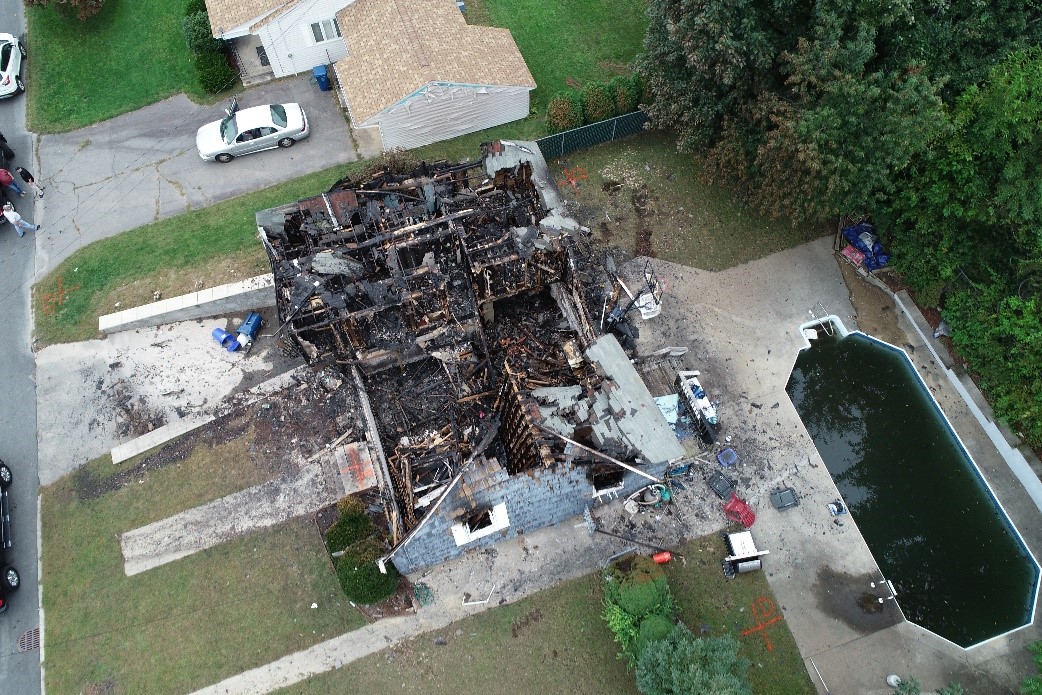Preliminary Report Pipeline: Over-pressure of a Columbia Gas of Massachusetts Low-pressure Natural Gas Distribution System
Executive Summary
The
information in this report is preliminary and will be either
supplemented or corrected during the course of the investigation.
On September 13, 2018, about 4:00 p.m.
eastern daylight time, a series of explosions and fires occurred after
high-pressure natural gas was released into a low-pressure gas
distribution system in the northeast region of the Merrimack Valley in
the state of Massachusetts.1 (See figure 1.) The distribution system was
owned and operated by Columbia Gas of Massachusetts (Columbia Gas), a
subsidiary of NiSource. The system over-pressure damaged 131 structures,
including at least 5 homes that were destroyed in the city of Lawrence
and the towns of Andover and North Andover. Most of the damage was a
result of structure fires ignited by gas-fueled appliances. Several
structures were destroyed by natural gas explosions. One person was
killed and at least 21 individuals, including 2 firefighters, were
transported to the hospital. Seven other firefighters received minor
injuries.
 Figure 1. Area impacted by accident depicting structures that were damaged.
Figure 1. Area impacted by accident depicting structures that were damaged.
Fire departments from the three
municipalities were dispatched to address the multiple fires and
explosions. (See figures 2 and 3.) First responders initiated the
state’s fire mobilization plan, that included mutual aid from other
districts in Massachusetts, New Hampshire, and Maine.

Figure 2. Aerial view of damaged home where a fatality occurred after the chimney collapsed on vehicle in the driveway.
 Figure 3. Aerial view of burned-out home impacted by the event.
Figure 3. Aerial view of burned-out home impacted by the event.
Emergency responders asked residents to
evacuate from the impacted area to four evacuation centers. At the
request of emergency management officials, National Grid shut down
electrical power in the affected area to remove a source of ignition.
Nearby roads were closed, and freight and passenger railroad operations
were suspended. Columbia Gas also shut down the low-pressure, natural
gas distribution system.[2]
The cast-iron, low-pressure distribution
system was installed in the early 1900s and had been partially improved
with both steel and plastic pipe upgrades since the 1950s. The
low-pressure distribution system in the affected area relied on 14
regulator stations to control gas at the required pressure into
structures serviced by the system, unlike high-pressure gas distribution
systems that place an individual regulator to reduce pressure at each
customer service.[3] Each of the regulator stations reduced the pressure
from about 75-pounds per square inch gauge (psig) natural gas main
pipeline to 12 inches of water column (about 0.5 psig) for delivery to
customers.
Prior to the over-pressure event, a Columbia
Gas-contracted work crew, which included a Columbia Gas inspector, was
performing a Columbia Gas-designed and approved pipe-replacement project
at a nearby intersection (South Union Street and Salem Street) in South
Lawrence. The contracted crew was working on a tie-in project of a new
plastic distribution main and the abandonment of a cast-iron
distribution main. The distribution main that was abandoned still had
the regulator sensing lines that were used to detect pressure in the
distribution system and provide input to the regulators to control the
system pressure. Once the contractor crews disconnected the distribution
main that was going to be abandoned, the section containing the sensing
lines began losing pressure.
As the pressure in the abandoned distribution
main dropped about 0.25 inches of water column (about 0.01 psig), the
regulators responded by opening further, increasing pressure in the
distribution system. Since the regulators no longer sensed system
pressure they fully opened allowing the full flow of high-pressure gas
to be released into the distribution system supplying the neighborhood,
exceeding the maximum allowable pressure.
Columbia Gas developed and approved the work
package executed on the day of the accident. The work package did not
account for the location of the sensing lines or require their
relocation to ensure the regulators were sensing actual system pressure.
The work was performed in accordance with steps laid out in the work
package. In light of this accident, Columbia Gas implemented a safety
stand-down for all employees who perform work related to low-pressure
natural gas systems for NiSource subsidiaries.[4]
Minutes before the fires and explosions
occurred, the Columbia Gas monitoring center in Columbus, Ohio, received
two high-pressure alarms for the South Lawrence gas pressure system:
one at 4:04 p.m. and the other at 4:05 p.m. The monitoring center had no
control capability to close or open valves; its only capability was to
monitor pressures on the distribution system and advise field
technicians accordingly. Following company protocol, at 4:06 p.m., the
Columbia Gas controller reported the high-pressure event to the Meters
and Regulations group in Lawrence. A local resident made the first 9-1-1
call to Lawrence emergency services at 4:11 p.m.
Columbia Gas shut down the regulator at issue
by about 4:30 p.m. The critical valves of the involved natural gas
distribution system were closed by 7:24 p.m. Beginning about midnight,
crews consisting of two Columbia Gas technicians escorted by two
emergency response personnel began shutting off the meters at each house
to isolate the homes from the natural gas distribution system. All
meters were shut off by the following morning.
National Transportation Safety Board (NTSB)
Chairman Robert Sumwalt and Member Jennifer Homendy led a 19-member NTSB
team on scene. Parties to the investigation include NiSource, Columbia
Gas, Pipeline and Hazardous Materials Safety Administration,
Massachusetts State Police, and Massachusetts Department of Public
Utilities. In addition to the on-scene work, investigators interviewed
multiple people including two Columbia Gas Supervisory Control and Data
Acquisition controllers from Columbus, Ohio.
According to Columbia Gas, all cast iron and
bare steel piping in the affected neighborhoods will be replaced due to
system integrity concerns. The new system will consist of high-pressure
plastic mains with regulators at each service meter to reduce the line
pressure from the main to the required pressure. The Massachusetts
Department of Public Utilities is providing oversight of the new system
installation to ensure that all work complies with state and federal
safety regulations.
The NTSB’s investigation into this accident
is ongoing. Future investigative issues include the coordination between
the emergency responders and Columbia Gas; an analysis of the
engineering work package preparation and execution, including the design
documentation; and a review of construction packages for
constructability and safety.
1. Title 49 Code of Federal Regulations (CFR)
192.3 defines a low-pressure distribution system as “a distribution
system in which the gas pressure in the main is substantially the same
as the pressure provided to the customer.” The Massachusetts Natural Gas
Pipeline Safety Code, Title 220 Code of Massachusetts Regulations (CMR)
101.06, further defines a low-pressure distribution system “as any
system in which the gas pressure in the main is equal to or less than
two psig (pounds per square inch gauge).”
2. Columbia Gas delivers natural gas to about
320,000 natural gas customers in southeastern Massachusetts, including
the Merrimack Valley.
3. Title 49 CFR 192.3 defines a
high-pressure distribution system as “a distribution system in which the
gas pressure in the main is higher than the pressure provided to the
customer.” The Massachusetts Natural Gas Pipeline Safety Code, 220 CMR
101.06, further defines a high-pressure distribution system “as a system
in which the pressure in the main is greater than 60 psig, but equal to
or less than 200 psig.”
4. A safety stand-down is an
organized break from work by which employers hold discussions with their
employees. They are often taken as occasions to discuss safety topics
while also reinforcing the organization’s policies regarding safety in
general.
Probable Cause
The
information in this report is preliminary and will be either
supplemented or corrected during the course of the investigation.